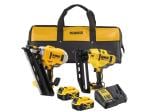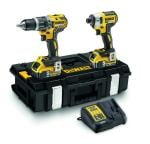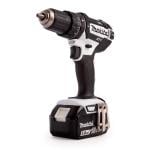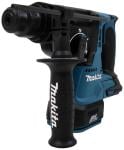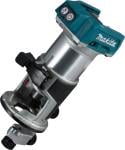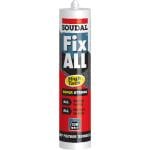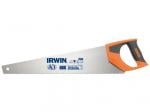The 7 Types of Angle Grinder Discs and Their Various Uses
The angle grinder is one of the most versatile power tools that any tradesman can have in their toolkit. The reason for this is because an angle grinder has a variety of different grinder discs which can be swapped out, depending on the task at hand. You see, mastering the angle grinder can take quite some practice, given how many different gradients and sizes there are (not to mention technique). However, by the end of this article, you should have a much clearer idea as to what the seven different types of angle grinder discs are, and what they can be used for. Let’s get started!
1 – Grinding wheel (angle grinder disc)
What is a grinding wheel?
- First, we’ll start with the obvious choice; the grinding wheel. These are disc-shaped and tend to feature a ribbed edge that is suitable for grinding rough metal edges with rapid succession.
- Grinding discs are most often used for all kinds of fabrication jobs that require a fresh and smooth finish.
- You can also use a grinding wheel to smooth out a fresh weld.
- Just remember that when working with this type of angle grinder disc, you should A. take the necessary safety precautions, and B. use the appropriate PPE.
- Do not touch your grinding wheel after use (they generate a lot of heat) – the ceramic grinding wheel is a suitable alternative.
2 – Cut-off wheel (angle grinder disc)
What is a cut-off wheel?
- Angle grinders can also be used to cut into metal stock, using a cut-off wheel.
- Cut-off wheel discs tend to have a thin profile with a tapered edge that makes them suitable for slicing into metal (plate metal, rebar, bolts, and so on).
- Thinner cut-off wheels can become unstable so make sure that you use a thicker cut-off wheel when going after stronger metals.
3 – Flap disc (angle grinder disc)
What is a flap disc?
- Flap discs are used on jobs that require the user to handle the metal in question. Think of them as fine sandpaper, but for rougher metals.
- Flap discs are used for removing metal burrs, sharp corners, and provide enhanced precision.
- Certain flap discs can be used for buffing out scratches as well—ideal for renovating metal.
4 – Wire wheel (angle grinder discs)
What is a wire wheel?
- Wire wheels can be used for tasks such as removing rust or paint (and other adhesives) from metal surfaces and rendering them ready for work.
- The metal wire fibres are either straight or intertwined, maximising their abrasive quality.
- Wire wheels do vary significantly in quality. As such, you should always avoid cheap wire wheels that are likely to degrade quickly (flying wires are a nuisance).
- Again, always wear PPE, as wire wheels can be very dangerous after extended use.
5 – Diamond disc (angle grinder disc)
What is a diamond disc?
- A diamond disc can come in several different forms; however, most are designed for cutting.
- Diamond discs provide excellent cutting for extra-dense metals.
- Diamond discs have a layer of abrasive diamond shards, making them excellent for blitzing through various tasks.
- Diamond discs can be expensive and thus should be reserved for the priority jobs where speed and precision is a must.
6 – Strip disc (angle grinder disc)
What is a strip disc?
- Where a wire wheel disc can be used to remove paint and rust efficiently, they can often scratch the underlying metal if not careful. As such, having a strip disc in your toolkit is handy for when the more delicate tasks present themselves.
- A poly-fiber material is used on strip discs for gently removing paint, epoxy, and glue etc. from metal surfaces.
- If working with wood or fibreglass, a strip disc is far more appropriate than a wire wheel.
7 – Ceramic sanding disc (angle grinder disc)
What is a ceramic sanding disc?
- Ceramic sanding discs are the least commonly used, even though they have an extended life compared to their counterpart discs.
- A ceramic sanding disc can do just about all of the tasks that a flap disc can.
- A great benefit of using ceramic is the fact that they do not overheat.
- Some high-quality ceramic sanding disks can provide a higher sanding capacity, coupled with superior durability.
Why buy an angle grinder?
So, is it worth buying an angle grinder? The short answer is yes. They’re one of the most versatile power tools that can replace many others in certain tasks, with the right disc attachment. This allows you to get through the more laborious tasks, faster. In addition to that, angle grinders are rather easy to control (especially for newbies)—so long as the correct safety precautions are taken into account, and PPE is worn at all times. If you are planning a project and expect to be working with various metals, then an angle grinder is the ideal fabricating power tool that can help you make light work of it.
Conclusion
Again, angle grinders are versatile multi-purpose tools that can be used by both professional fabricators and amateurs alike. However, before getting stuck in and using yours, just make sure that you are using the appropriate angle grinder disc. Here’s a quick summary:
- Grinding wheel: Smoothing rough edges
- Cut-off wheel: Slicing into metal
- Flap disc: Smoothing rough surfaces for safe handling
- Wire wheel: Removing rust and paint (and other adhesives)
- Diamond disc: Cutting (with greater precision and efficiency)
- Strip disc: A less-invasive disc for removing rust and paint
- Ceramic sanding disc: Smoothing rough surfaces (without overheating)
We hope that you have found this article helpful. Now, you should be able to invest in several different angle grinder discs, preparing you for all manner of metal-working tasks. Good luck and stay safe!


